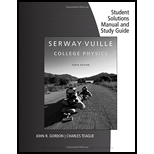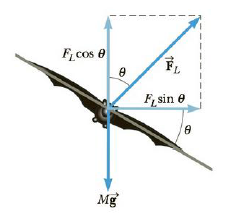
Concept explainers
The maximum lift force on a bat is proportional to the square of its flying speed v. For the hoary bat (Lasiurus cinereus), the magnitude of the lift force is given by
Fl ≤ (0.018 N · s2/m2) v2
The bat can fly in a horizontal circle by “banking” its wings at an angle θ, as shown in Figure P7.72. In this situation, the magnitude of the vertical component of the lift force must equal the bat’s weight. The horizontal component of the

Figure P7.72.
force provides the centripetal acceleration. (a) What is the minimum speed that the bat can have if its mass is 0.031 kg? (b) If the maximum speed of the bat is 10 m/s, what is the maximum banking angle that allows the bat to stay in a horizontal plane? (c) What is the radius of the circle of its flight when the bat flies at its maximum speed? (d) Can the bat turn with a smaller radius by flying more slowly?
Trending nowThis is a popular solution!

Chapter 7 Solutions
EBK STUDENT SOLUTIONS MANUAL WITH STUDY
Additional Science Textbook Solutions
College Physics: A Strategic Approach (3rd Edition)
Brock Biology of Microorganisms (15th Edition)
Campbell Essential Biology with Physiology (5th Edition)
Fundamentals Of Thermodynamics
Loose Leaf For Integrated Principles Of Zoology
Applications and Investigations in Earth Science (9th Edition)
- The systems shown below are in equilibrium. If the spring scales are calibrated in newtons, what do they read? Ignore the masses of the pulleys and strings and assume the pulleys and the incline are frictionless. (Let m = 2.19 kg and € = 29.0°.) scale in (a) N N scale in (b) scale in (c) N scale in (d) N a C m m m m m b d m Ꮎarrow_forwardAn elevator car has two equal masses attached to the ceiling as shown. (Assume m = 3.10 kg.) m m T₁ T2 (a) The elevator ascends with an acceleration of magnitude 2.00 m/s². What are the tensions in the two strings? (Enter your answers in N.) = N T₁ Τι = N (b) The maximum tension the strings can withstand is 78.8 N. What is the maximum acceleration of the elevator so that a string does not break? (Enter the magnitude in m/s².) m/s²arrow_forward(a) At what speed (in m/s) will a proton move in a circular path of the same radius as an electron that travels at 7.85 x 100 m/s perpendicular to the Earth's magnetic field at an altitude where the field strength is 1.20 x 10-5 T? 4.27e3 m/s (b) What would the radius (in m) of the path be if the proton had the same speed as the electron? 7.85e6 x m (c) What would the radius (in m) be if the proton had the same kinetic energy as the electron? 195.38 x m (d) What would the radius (in m) be if the proton had the same momentum as the electron? 3.7205 marrow_forward
- ! Required information The block shown is made of a magnesium alloy, for which E = 45 GPa and v = 0.35. Know that σx = -185 MPa. NOTE: This is a multi-part question. Once an answer is submitted, you will be unable to return to this part. 25 mm B D 40 mm 100 mm Determine the magnitude of Oy for which the change in the height of the block will be zero. The magnitude of Oy is MPa.arrow_forwardThe rigid bar ABC is supported by two links, AD and BE, of uniform 37.5 × 6-mm rectangular cross section and made of a mild steel that is assumed to be elastoplastic with E = 200 GPa and σy= 250 MPa. The magnitude of the force Q applied at B is gradually increased from zero to 265 kN and a = 0.640 m. 1.7 m 1 m D A B 2.64 m E Determine the value of the normal stress in each link. The value of the normal stress in link AD is The value of the normal stress in link BE is 250 MPa. MPa.arrow_forwardTwo tempered-steel bars, each 16 in. thick, are bonded to a ½ -in. mild-steel bar. This composite bar is subjected as shown to a centric axial load of magnitude P. Both steels are elastoplastic with E= 29 × 106 psi and with yield strengths equal to 100 ksi and 50 ksi, respectively, for the tempered and mild steel. The load P is gradually increased from zero until the deformation of the bar reaches a maximum value dm = 0.04 in. and then decreased back to zero. Take L = 15 in. NOTE: This is a multi-part question. Once an answer is submitted, you will be unable to return to this part. 2.0 in. in. 3 in. 3 16 in. Determine the maximum stress in the tempered-steel bars. The maximum stress in the tempered-steel bars is ksi.arrow_forward
- Ammonia enters the compressor of an industrial refrigeration plant at 2 bar, -10°C with a mass flow rate of 15 kg/min and is compressed to 12 bar, 140°C. Heat transfer from the compressor to its surroundings occurs at a rate of 6 kW. For steady-state operation, calculate, (a) the power input to the compressor, in kW, Answer (b) the entropy production rate, in kW/K, for a control volume encompassing the compressor and its immediate surroundings such that heat transfer occurs at 300 K.arrow_forwardNo chatgpt pls will upvotearrow_forwardShown to the right is a block of mass m=5.71kgm=5.71kg on a ramp that makes an angle θ=24.1∘θ=24.1∘ with the horizontal. This block is being pushed by a horizontal force, F=229NF=229N. The coefficient of kinetic friction between the two surfaces is μ=0.51μ=0.51. Enter an expression for the acceleration of the block up the ramp using variables from the problem statement together with gg for the acceleration due to gravity. a=arrow_forward
- If the density and atomic mass of copper are respectively 8.80 x 103 kg/m³ and 63.5 kg/kmol (note that 1 kmol = 1,000 mol), and copper has one free electron per copper atom, determine the following. (a) the drift speed of the electrons in a 10 gauge copper wire (2.588 mm in diameter) carrying a 13.5 A current 1.988-4 See if you can obtain an expression for the drift speed of electrons in a copper wire in terms of the current in the wire, the diameter of the wire, the molecular weight and mass density of copper, Avogadro's number, and the charge on an electron. m/s (b) the Hall voltage if a 2.68 T field is applied perpendicular to the wire 3.34e-6 x Can you start with basic equations for the electric and magnetic forces acting on the electrons moving through the wire and obtain a relationship between the magnitude of the electric and magnetic field and the drift speed of the electrons? How is the magnitude of the electric field related to the Hall voltage and the diameter of the wire? Varrow_forward(a) At what speed (in m/s) will a proton move in a circular path of the same radius as an electron that travels at 7.85 x 100 m/s perpendicular to the Earth's magnetic field at an altitude where the field strength is 1.20 x 10-5 T? 4.27e3 m/s (b) What would the radius (in m) of the path be if the proton had the same speed as the electron? 0.685 x m (c) What would the radius (in m) be if the proton had the same kinetic energy as the electron? 0.0084 m (d) What would the radius (in m) be if the proton had the same momentum as the electron? 0.0303 x marrow_forwardTwo charges are placed on the x axis. One of the charges (91 = +6.63 μC) is at x₁ = +3.00 cm and the other (92 = -24.2 μC) is at x2 = +9.00 cm. Find the net electric field (magnitude and direction given as a plus or minus sign) at (a) x = 0 cm and (b) x = +6.00 cm.arrow_forward
 Physics for Scientists and Engineers: Foundations...PhysicsISBN:9781133939146Author:Katz, Debora M.Publisher:Cengage Learning
Physics for Scientists and Engineers: Foundations...PhysicsISBN:9781133939146Author:Katz, Debora M.Publisher:Cengage Learning Principles of Physics: A Calculus-Based TextPhysicsISBN:9781133104261Author:Raymond A. Serway, John W. JewettPublisher:Cengage Learning
Principles of Physics: A Calculus-Based TextPhysicsISBN:9781133104261Author:Raymond A. Serway, John W. JewettPublisher:Cengage Learning Glencoe Physics: Principles and Problems, Student...PhysicsISBN:9780078807213Author:Paul W. ZitzewitzPublisher:Glencoe/McGraw-Hill
Glencoe Physics: Principles and Problems, Student...PhysicsISBN:9780078807213Author:Paul W. ZitzewitzPublisher:Glencoe/McGraw-Hill Classical Dynamics of Particles and SystemsPhysicsISBN:9780534408961Author:Stephen T. Thornton, Jerry B. MarionPublisher:Cengage Learning
Classical Dynamics of Particles and SystemsPhysicsISBN:9780534408961Author:Stephen T. Thornton, Jerry B. MarionPublisher:Cengage Learning College PhysicsPhysicsISBN:9781305952300Author:Raymond A. Serway, Chris VuillePublisher:Cengage Learning
College PhysicsPhysicsISBN:9781305952300Author:Raymond A. Serway, Chris VuillePublisher:Cengage Learning College PhysicsPhysicsISBN:9781285737027Author:Raymond A. Serway, Chris VuillePublisher:Cengage Learning
College PhysicsPhysicsISBN:9781285737027Author:Raymond A. Serway, Chris VuillePublisher:Cengage Learning





